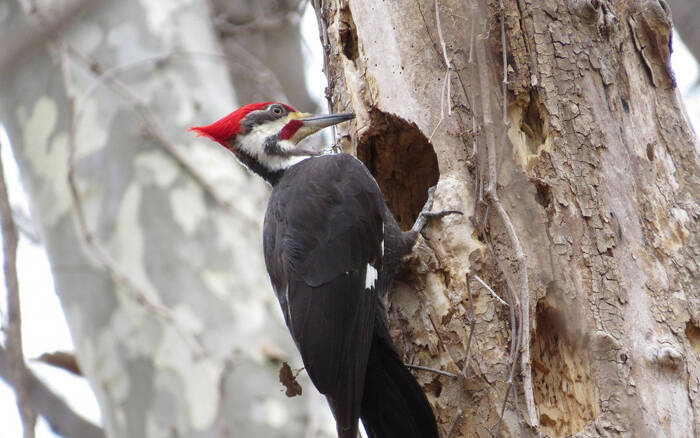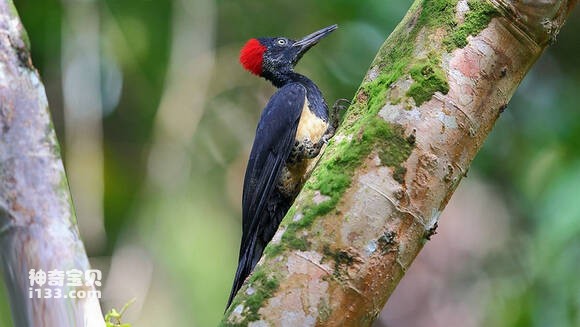Dryocopus javensis
IUCN
LCBasic Information
Scientific classification
- name:Dryocopus javensis
- Scientific Name:Dryocopus javensis,White-bellied woodpecker
- Outline:Climbing birds
- Family:Picipitidae Picidae B.Woodpecker
Vital signs
- length:43-46cm
- Weight:50-100g
- lifetime:20-30years
Feature
The top of the head has a long red crest, the jawline is also red, the rest of the head, neck, chest and upper body are black, and the waist and abdomen are white
Distribution and Habitat
The white-bellied black woodpecker is distributed in southwest Sichuan, Lushui, Lijiang, Lancang River, Menghai, Mengyang and the mountains between Nujiang River and Lancang River in China. Outside China, it is distributed in North Korea, India, Myanmar, Thailand, Indochina Peninsula, Malay Peninsula, Philippines and Indonesia.
The white-bellied black woodpecker mainly inhabits mountain coniferous forests, mixed coniferous and broad-leaved forests and evergreen and deciduous broad-leaved forests below 2,000 meters above sea level, and sometimes appears at the foot of the mountain and in the secondary forests at the edge of the forest.
Appearance
The male white-bellied black woodpecker has a red forehead, top of the head, and nape. The feathers on the top of the head and nape are very long, forming a long red crest; the jaw pattern is red, the lower chest, abdomen and waist are white, and the rest of the body feathers are black; the back, shoulders and upper wing coverts have a copper-green luster; the chin, throat, front neck and neck sides have white stripes; the primary flight feathers have white tips, the inner primary flight feathers and the outer secondary flight feathers are white, and the back of the two flanks and the undertail coverts are decorated with brown. The armpits and underwing coverts are white.
The female white-bellied black woodpecker is similar to the male, but the top of the head and jaw pattern are not red, but black like the body feathers. The rest is similar to the male.
The iris of the white-bellied black woodpecker is yellowish white to bright yellow, the bill is dark lead, the tip is almost bl
Details
White-bellied Black Woodpecker is a medium-sized bird of the Picidae family and the genus Black Woodpecker, with 15 subspecies.

White-bellied Black Woodpeckers often move alone or in pairs, and occasionally small groups can be seen. They mostly move and forage in the middle and upper parts of tall trees. Their wings are short and blunt, which is not suitable for fast or long-distance flying. They only glide in the air in a wave-like manner. When feeding, it can climb up and down or spiral along the tree trunk to the sides, and can also jump forward and backward with its feet. It mainly feeds on ants and insects, including Coleoptera, Lepidoptera, Geometridae larvae, Tettigoniidae, Acrididae, Noctuidae larvae, Leptinotarsa larvae, Lycopodidae larvae, butterfly larvae, caterpillars, crickets, mantises and other insects, and also eats a small amount of plant fruits and seeds.

The breeding season of the White-bellied Black Woodpecker is from April to June. It nests in tree holes. The nest holes are mostly chosen on tall dead trees and dead trees. The male and female birds peck the holes themselves. The height of the hole is mostly 4-15 meters from the ground. Each nest lays 2-4 eggs, which are white and 32-37 mm × 23-29 mm in size. Male and female take turns incubating eggs. The chicks mature late.

The white-bellied black woodpecker has a wide distribution range and is not close to the vulnerable and endangered critical value standard for species survival (distribution area or fluctuation range is less than 20,000 square kilometers, habitat quality, population size, and distribution area fragmentation), so it is evaluated as a species of least concern. The white-bellied black woodpecker population is scarce in China.

Listed in the IUCN Red List of Threatened Species in 2016, ver 3.1 - Least Concern (LC).
Listed in the CITES Appendix of the Washington Convention: Ⅰ.
Listed as a Class II protected animal in the "National List of Key Protected Wildlife" issued by the Ministry of Forestry and the Ministry of Agriculture of China on January 14, 1989.
Listed in the Red List of Chinese Species - Endangered (EN).
Listed as Class II in China's "National List of Key Protected Wildlife" (February 5, 2021).
Protect wildlife and eliminate game.
Maintaining ecological balance is everyone's responsibility!








